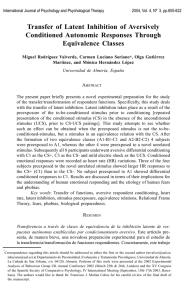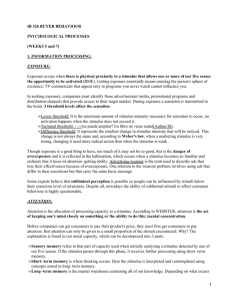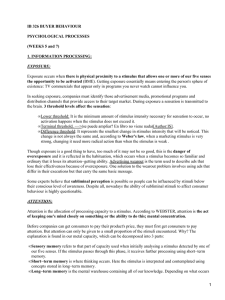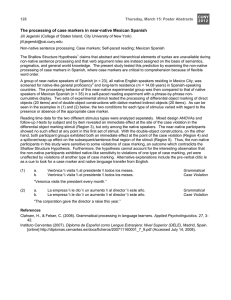Redalyc. Using stimulus equivalence to
Anuncio
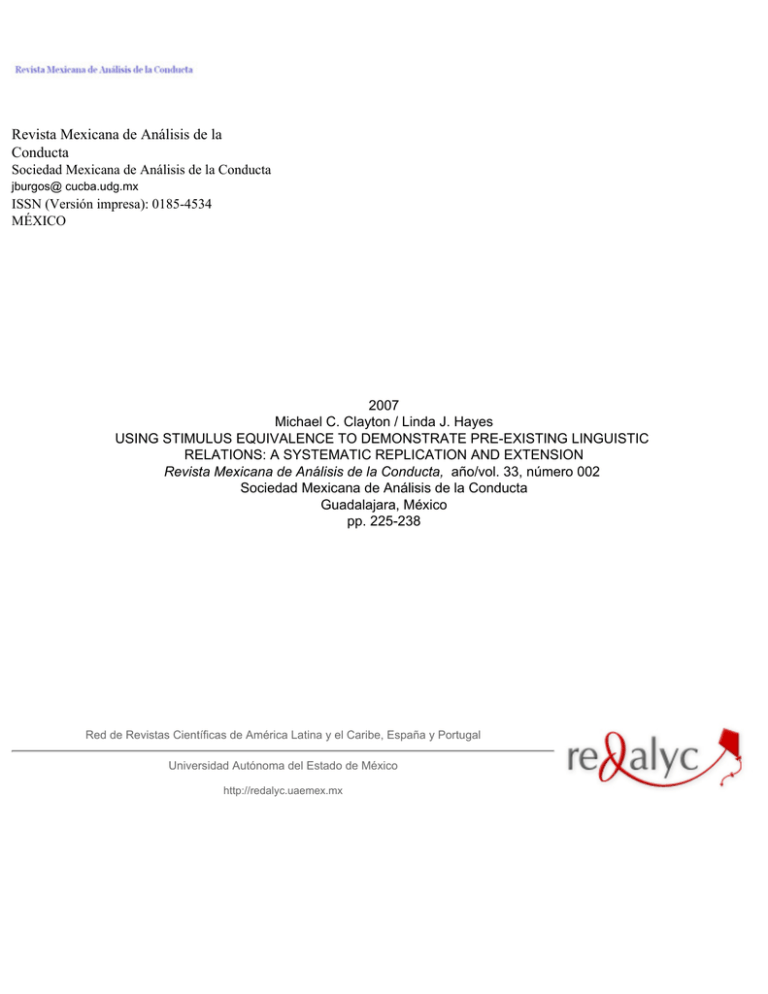
Revista Mexicana de Análisis de la Conducta Sociedad Mexicana de Análisis de la Conducta jburgos@ cucba.udg.mx ISSN (Versión impresa): 0185-4534 MÉXICO 2007 Michael C. Clayton / Linda J. Hayes USING STIMULUS EQUIVALENCE TO DEMONSTRATE PRE-EXISTING LINGUISTIC RELATIONS: A SYSTEMATIC REPLICATION AND EXTENSION Revista Mexicana de Análisis de la Conducta, año/vol. 33, número 002 Sociedad Mexicana de Análisis de la Conducta Guadalajara, México pp. 225-238 Red de Revistas Científicas de América Latina y el Caribe, España y Portugal Universidad Autónoma del Estado de México http://redalyc.uaemex.mx Revista Mexicana de Análisis de la Conducta 2007Número 2 (dic) Mexican Journal of Behavior Analysis 33, 225-238Number 2 (dec) Using Stimulus Equivalence to Demonstrate Pre-Existing Linguistic Relations: A Systematic Replication and Extension El uso de la equivalencia de estímulos para demostrar relaciones lingüísticas preexistentes: Una réplica systemática y extensión 2 Michael C. Clayton2 y Linda J. Hayes3 Youngstown State University, 3University of Nevada Abstract The stimulus equivalence paradigm was used to discover whether or not preexperimental histories with respect to affective stimuli could be brought to bear in an experimental setting. In two experiments, undergraduate students were trained in A-B, A-C, and D-C conditional relations using a match-to-sample procedure. The A and B stimuli were arbitrary visual forms, and the C stimuli were Chinese ideograms. The D stimuli for one group consisted of English words like “Holiday”, “Funeral”, and “Torture” and for the other group the D stimuli consisted of human faces expressing happiness, sadness, and anger. Equivalence relations were tested between the D stimuli and the B, A, and C stimuli with the condition that D stimuli used during testing were not the same as the D stimuli used during training. Thus, subjects trained with faces were tested with words and subjects trained with words were tested with faces. Substitutional equivalence emerged for most subjects who showed non-substitutional equivalence (B-C, C-B). Substitutional equivalence emerged more readily for subjects trained with words and tested with faces than they did for 1.Address editorial correspondence to: Michael Clayton, Ph.D. Psychology Department – YSU. One University Plaza. Youngstown, OH 44555. Email: [email protected] 226 Michael C. Clayton y Linda J. Hayes subjects trained with faces and tested with words. Results are discussed in terms of stimulus function and pre-experimental histories. Key words: stimulus equivalence, pre-existing linguistic relations, stimulus function, pre-experimental history, words, faces. resumen El paradigma de la equivalencia de estímulos fue usado para descubrir si historias preexperimentales con respecto a estímulos afectivos podían revelarse en un arreglo experimental. En dos experimentos, estudiantes de licenciatura fueron entrenados en relaciones condicionales A-B, A-C y D-C, usando un procedimiento de igualación a la muestra. Los estímulos A y B fueron formas visuales arbitrarias, y los estímulos C fueron ideogramas chinos. Los estímulos D para un grupo consistieron en palabras en inglés como “Holiday”, “Funeral”, y “Torture y para otro grupo los estímulos D consistieron en rostros humanos que expresaban felicidad, tristeza e ira. Se probaron las relaciones de equivalencia entre los estímulos D y los estímulos B, A, y C, con la condición de que los estímulos D usados durante la prueba no fueran los mismos que los estímulos D usados durante el entrenamiento. Por tanto, los sujetos entrenados con los rostros fueron probados con palabras, y los sujetos entrenados con las palabras fueron probados con los rostros. La equivalencia sustitutiva emergió para la mayoría de los sujetos que mostraron equivalencia non-sustitutiva (B-C, C-B). La equivalencia sustitutiva emergió más claramente en los sujetos entrenados con palabras y probados con rostros, que para los sujetos entrenados con rostros y probados con palabras. Los resultados se discuten en términos de la función de estímulo y las historias pre-experimentales. Palabras clave: equivalencia de estímulos, relaciones linfüísticas preexistentes, función de estímulom historia pre-experimental, palabras, rostros When verbally able human subjects are taught a series of interrelated conditional discriminations, the stimuli used often become related to each other in untrained ways. For example, a subject is taught to select stimulus B in the presence of stimulus A. That subject is also taught to select stimulus C in the presence of stimulus A. Thereafter, it is very likely that the subject will select stimulus A in the presence of either B or C (symmetry), and B in the presence of C and C in the presence of B (equivalence) without explicit training to do so. The stimulus equivalence paradigm is a relatively simple procedure that has been used to great effect over time to explore complex human behavior. First, the procedure has been used to remediate the language deficits of verbally disabled persons (Sidman & Tailby, 1982; Cowley, Green, Braunling- Equivalence and Pre-existing linguistic relations 227 McMorrow, 1992). Second, researchers have used the paradigm to develop a behavior analytic interpretation of symbolic meaning and the generative nature of grammar (Hayes, Barnes-Holmes, Roche, 2001; Barnes & Holmes, 1991; Hayes & Hayes, 1989; Wulfert & Hayes, 1988). Finally, research has shown that equivalence is important to a behavioral analysis of many divergent areas of research, such as social categorization (Roche, BarnesHolmes, Barnes-Holmes, 2001; Kohlenberg, Hayes, & Hayes, 1991; Grey & Barnes, 1996), human sexual behavior (Roche, Barnes-Holmes, Smeets, Barnes-Holmes, & McGeady, 2000; Roche, Barnes, & Smeets, 1997), as well as the advanced reasoning abilities of humans (Hayes, Gifford, & Townsend, 2001; Lipkens, 1992). A less examined, but potentially important, role for the equivalence procedure is its use in identifying and studying extra-experimentally established linguistic relations. For example, a smiling face and the word “happy” can be assumed to be members of the same stimulus class, as are words like “celebration” and “holiday”. It is common in Western cultures to think “happy” upon seeing a smiling face. After bringing “happy” into the present setting in this way, you may be reminded of occasions upon which you were happy (e.g., birthday). Each of these different reactions shares membership in the same or overlapping relational classes or frames (Hayes & Barnes, 1997; Barnes, 1994; Barnes & Hampson, 1993; Blackledge, 2003). Taking advantage of culturally probable equivalence relations, Hayes, Brenner, and Hayes (1994) examined the extent to which particular stimuli acquire functions of their settings and settings acquire functions of the stimuli found in them. Normal adult subjects were trained in A-B, A-C, and D-C conditional relations using a match-to-sample procedure. The A, B, and C stimuli were arbitrary visual forms, while the D stimuli were either words or pictures dependent on group assignment. Subjects trained with words (happy, funeral, torture) were tested with human faces (happy, sad, or angry expression). Equivalence relations were tested between the D stimuli and the B, A, and C stimuli (D-B, B-D, A-D, C-D) using the D stimuli seen by the other group in training. Substitutional equivalence emerged for most, but not all, subjects who showed non-substitutional equivalence (B-C, C-B). Additionally, substitutional equivalence emerged more readily for subjects trained with words and tested with faces, than the converse. The present study was intended to replicate, simplify, and extend the procedures of the Hayes et al. (1994) study. Thirty subjects in two experiments were trained and tested on equivalence relations using faces, Chinese ideograms, arbitrary symbols, and English words. Each experiment contained two groups; those who were trained with words and tested with faces and those were trained with faces and tested with words. 228 Michael C. Clayton y Linda J. Hayes Experiment 1 General Method Participants Twelve undergraduate students (4 males and 8 females) at a medium-sized, public university in the United States participated in exchange for extra credit in their psychology courses. All subjects signed a statement of informed consent and were told that they could withdraw at any time. The experiment lasted approximately 45 minutes and subjects were thoroughly debriefed upon completion. Apparatus Each session was conducted in a quiet experimental room with an IBM-compatible personal computer, table, and chair. The computer was positioned centrally on a 3’ x 2’ table. Participant data was entered using the keyboard; all subsequent interaction was completed using the computer’s mouse. The computer, using software that was programmed in Microsoft Visual Basic by the first author, performed stimulus presentation and the recording of responses. A pool of 15 images (Figure 1) was randomly assigned to their respective roles as sample and comparison stimuli. Stimuli were 2.5 cm in diameter and were arbitrarily divided into four stimulus classes. In the interest of clarity, the designations A1-3-D1-3 are used hereafter. Pre-Existing Linguistic Relations 6 1 2 3 A B C D1 D2 Procedure Figure 1. The fifteen stimuli usedassigned in Experiment Participants were randomly to one of two1. groups and trained in A-B, A-C, and D-C conditional relations using a match-to-sample procedure (Figure 2). The A and B stimuli were arbitrary visual forms, and the C stimuli were Chinese ideograms (see Fig. 1). The D stimuli were either iconic human faces or common English words, depending on which of two conditions the subjects found themselves in. The first group was trained with stylized faces and then tested with English words and the second Equivalence and Pre-existing linguistic relations 229 Procedure Participants were randomly assigned to one of two groups and trained in A-B, A-C, and D-C conditional relations using a match-to-sample procedure (Figure 2). The A and B stimuli were arbitrary visual forms, and the C stimuli were Chinese ideograms (see Fig. 1). The D stimuli were either iconic human faces or common English words, depending on which of two conditions the subjects found themselves in. The first group was trained with stylized faces and then tested with English words and the second group was trained with English Pre-Existing Linguistic Relations 7 words and tested with iconic faces. ________________ Figure 2. Diagram of trained and tested stimulus relations. A solid line indicates relations that were directly trained. A dotted line indicates derived relations that were tested. Dsub substituted for D during tests. 230 Michael C. Clayton y Linda J. Hayes Training Phase Prior to beginning the experiment, the subjects were presented with the following instructions: In parts of this study, an object will appear on the computer screen. You should then select it by moving the mouse pointer on top of it and singleclicking the left mouse button. A moment later, additional objects will appear on the screen. Select one of these objects by single-clicking on it with the left mouse button. Sometimes you will be told if your selection is correct or incorrect; sometimes you will not get any feedback. The trained relations of A-B, A-C, and D-C were established using a standard match-to-sample (MTS) procedure. The sample stimulus appeared in the top-center portion of the computer screen, and the comparisons appeared, left-to-right, in the bottom-center portion of the screen. Subjects were instructed to select stimuli on the computer screen with the mouse when they were presented with a sample stimulus and they would receive feedback as to their accuracy. Feedback consisted of the word “CORRECT” or “INCORRECT” in the middle of the screen following stimulus selection. Training continued until subjects reached a criterion of 100% correct during one entire training phase. A training phase consisted of two instances of each relation, A1-3-B1-3, A1-3-C1-3, D1-3-C1-3, for a total of 18 individual trials. Testing Phases Pre-Existing Linguistic Relations 9 After a subject reached the training criterion (100%) they were then exposed to the testing phase of the study (Figure 3). The testing phases were carried out in the C-Dsub) same fashion as the for training phases, is, usingThis a standard A, C-A, one time, a total of that 9 trials. phase MTS procedure. Theby first testing training phase tested each of the symmetrical was followed another phase conducted until the relations (B-A, C-A, C-Dsub) one time, for a total of 9 trials. This phase was followed subject reached the training criterion of 100%. The subject was by another training phase conducted until the subject reached the training then exposed to The the subject secondwas testing phase that of phase the criterion of 100%. then exposed to thetested secondeach testing equivalence relations (B-C, C-B) one time, a one total of for 6 a total that tested each of the equivalence relations (B-C,for C-B) time, of 6 trials.After After one training phase,phase, subjects were then tested for further, trials. onefinal final training subjects were then extended, relations (B-Dsub, Dsub-B, A-Dsub) (B-Dsub, for a total of 9 tested forequivalence further, extended, equivalence relations unique testing trials. Dsub-B, A-Dsub) for a total of 9 unique testing trials. Trials were designated asthe non-substitutional Figure 3. Flowchart indicating sequence of trainingwhen and the testing used in Experiment 1 andhad Experiment 2. stimuli involved been presented during training. For example, the equivalence relations B-C or C-B are examples of non-substitutional equivalence relations because the B and C stimuli had been encountered during training as A-B and A-C relations. Substitutional equivalence refers to trials where some of the stimuli have not been seen by the participants until Equivalence and Pre-existing linguistic relations 231 Trials were designated as non-substitutional when the stimuli involved had been presented during training. For example, the equivalence relations B-C or C-B are examples of non-substitutional equivalence relations because the B and C stimuli had been encountered during training as A-B and A-C relations. Substitutional equivalence refers to trials where some of the stimuli have not been seen by the participants until this point in the study. For example, during training subjects were exposed to faces (D), but during testing English words (Dsub) were substituted for the faces seen during training. Results and Discussion Table 1 shows individual data for the six subjects trained with faces and tested with words and Table 2 shows the data for the six subjects trained with words and tested with faces. The first column indicates each of the six subjects, by number. Successive columns show the number of trials it took to reach the 100% training criterion, as well as the proportion of correct responses during tests for the various derived relations. Successful responding during tests for derived relations is defined as ≥90%. The bottom row indicates the respective means for each of the variables, beginning with trials to criterion and ending with the A-Dsub relation in testing. Ss 1 2 3 4 5 6 Mean Trials 16 15 17 6 17 12 14 B-A, C-A 1 1 0.83 1 0.83 1 0.94 C-Dsub 0 1 1 0 0.67 0.33 0.50 C-B, B-C 1 1 0.67 1 0.83 1 0.92 B-Dsub, Dsub-B 0 0.67 0.17 0.33 0.67 0.67 0.42 A-Dsub 0 1 0.33 0.33 1 0.67 0.56 Table 1. Subjects trained with faces and tested with words. Proportion of correct responses on tests for non-substitutional and substitutional equivalence relations, as well as number of trials to criterion during training. Table 1 shows that four subjects (1, 2, 4, 6) successfully completed tests for equivalence, while the rest (3, 5) scored less than 90% correct. Of the four successfully completing tests for non-substitutional relations, only one subject (2) subsequently completed the substitutional tests successfully. Table 2 indicates that all subjects successfully completed tests for equivalence as well as some substitutional relations. Two subjects (1, 3) completed all tested relations successfully while the rest failed at least on substitutional relations test. 232 Ss 1 2 3 4 5 6 Mean Michael C. Clayton y Linda J. Hayes Trials 18 11 3 6 15 23 13 B-A, C-A 1 0.83 1 0.83 1 0.83 0.92 C-Dsub 1 0.67 1 1 1 0.67 0.89 C-B, B-C 1 1 1 1 1 1 1.0 B-Dsub, Dsub-B 1 0.83 1 0.83 0.83 0.67 0.86 A-Dsub 1 1 1 0.67 1 1 0.95 Table 2. Subjects trained with words and tested with faces. Proportion of correct responses on tests for non-substitutional and substitutional equivalence relations, as well as number of trials to criterion during training. On tests for non-substitutional (B-A, C-A, B-C, C-B) derived relations both groups had similar proportions of correct responses, although the Word-Face group scored slightly better during tests for equivalence. In contrast, the summary data show a distinct difference in responding when comparing results on tests for substitutional derived relations. Subjects trained with words and then tested with faces did better on subsequent tests for substitutional relations than did subjects trained with faces and tested with words. The gradual emergence of some relations within the network can be seen regardless of success during tests for symmetry and equivalence. For example, subjects 3 and 5 (Table 1) scored below criterion for success during equivalence tests but successfully completed a test for substitutional relations anyway. Experiment 2 The results of Experiment 1 were in accordance with those of Hayes et al. (1994). The subjects showed derived relations when testing both substitutional and nonsubstitutional relations. Subjects trained with words and tested with faces, as well as those trained with faces and tested with words, performed equally well during tests for nonsubstitutional relations (symmetry and equivalence). The main difference between groups was the discrepancy in responding when faced with substitutional relations. In this case, subjects trained with words and tested with faces did much better than did subjects trained with faces and tested with words. Experiment 2 replicated Experiment 1, with the only difference being the substitution of black and white photos of actual human faces in place of the iconic faces in Experiment 1. Equivalence and Pre-existing linguistic relations 233 Participants Eighteen undergraduate students (5 males and 13 females) at a mediumsized, public university in the United States participated in exchange for extra credit in their psychology courses. All subjects signed a statement of informed consent and were told that they could withdraw at any time. The experiment lasted approximately 45 minutes and subjects were thoroughly debriefed upon completion. Procedure The procedure was identical to that of the prior experiment except that black and white photos of actual human faces (Figure 4) were substituted for the iconic faces of Experiment 1. In this respect, Experiment 2 more closely replicated the procedures of Hayes et al. (1994). The earlier study used photos of human faces, not iconic faces like in Experiment 1. The faces in the current Pre-Existing Linguistic Relations 12 study were acquired from Paul Ekman’s archive (Ekman, 2003), and are considered prototypical of each of the emotions (Happy, Sad, Angry) represented by the iconic faces in Experiment 1. Figure 4. The three D stimuli used in Experiment 2. Results and Discussion Results and Discussion Table shows individual data for the nine subjects trained Table 33shows individual data for the nine subjects trained with faces and tested with words, while Table 4 shows the data for the nine subjects trained with with faces and tested with words, while Table 4 shows the data words and tested with faces. The first column shows each subject, by number, for theand nine subjects trained with words with faces. the means at the bottom. Successive columnsand showtested the number of trials it tookcolumn to reach shows criterion each in the first training phase, as well as and resultsthe for each The first subject, by number, means at of the tested derived relations. A mean for trials to criterion as well as each of the bottom. columns show the of tables. trials it took the testsSuccessive for derived relations is shown on the finalnumber row of both to reach criterion in the first training phase, as well as results for each of the tested derived relations. A mean for trials to criterion as well as each of the tests for derived relations is shown on the final row of both tables. Table 3 shows that four subjects (5, 7, 8, 9) successfully completed tests for equivalence, while the rest (1, 2, 3, 4, 6) scored below criterion (<90%). Of the four successfully 234 Ss 1 2 3 4 5 6 7 8 9 Mean Michael C. Clayton y Linda J. Hayes Trials 41 56 23 12 35 95 19 24 11 35 B-A, C-A 1 0.67 1 0.83 1 1 1 1 1 0.94 C-Dsub 0.33 0.33 0.67 0.33 1 0.33 0 1 0.67 0.52 C-B, B-C 0.83 0.83 0.17 0.5 1 0.33 1 1 1 0.74 B-Dsub, Dsub-B 0 0.5 0.5 1 1 0 0.33 1 0.33 0.52 A-Dsub 0.67 0.33 0.67 0.33 1 1 0.67 1 0.33 0.67 Table 3. Subjects trained with faces and tested with words. Proportion of correct responses on tests for non-substitutional and substitutional equivalence relations, as well as number of trials to criterion during training. Table 3 shows that four subjects (5, 7, 8, 9) successfully completed tests for equivalence, while the rest (1, 2, 3, 4, 6) scored below criterion (<90%). Of the four successfully completing tests for non-substitutional relations, only two (5, 8) subsequently completed the tests for substitutional relations successfully. Table 4 indicates that four subjects (1, 4, 5, 7) successfully completed tests for equivalence while the rest (2, 3, 6, 8, 9) scored below criterion. Of the four successfully completing tests for non-substitutional relations, three (1, 4, 7) completed at least one test for substitutional relations successfully. In fact, Subject 4 completed all such tests successfully. Ss 1 2 3 4 5 6 7 8 9 Mean Trials 9 14 44 15 10 16 8 12 13 16 B-A, C-A 1 1 0.83 0.83 1 1 1 1 1 0.96 C-Dsub 0.67 1 1 1 0 0.33 0.67 0.67 1 0.70 C-B, B-C 1 0.83 0.67 1 1 0.83 1 0.83 0.83 0.89 B-Dsub, Dsub-B 1 0.83 0.67 1 0 0.17 0.83 0.83 1 0.70 A-Dsub 1 1 1 1 0 0.67 1 1 1 0.85 Table 4. Subjects trained with words and tested with faces. Proportion of correct responses on tests for non-substitutional and substitutional equivalence relations, as well as number of trials to criterion during training. Equivalence and Pre-existing linguistic relations 235 The data in Table 3 and Table 4 show the same general pattern of responding as that of Experiment 1. As in Experiment 1, participants that were trained with words and tested with faces did better on tests for derived relations than did the participants in the other condition. There were, however some differences. Participants in the group that was trained with faces and tested with words took more than twice as long (35 trials), on average, to reach the training criterion than did those in the group that was trained with words and tested with faces (16 trials). Another difference is that, in general, the participants in Experiment 2 responded correctly at lower rates, on average, than those in Experiment 1. The exception to this rule occurred in tests for symmetry (B-A, C-A), where correct responding was more frequent in Experiment 2, although the difference is not large. As in Experiment One, the gradual emergence of some relations within the network can be seen regardless of success with the symmetry and equivalence tests. For example, subjects 4, 6 (Table 3), 2, 3, 8, 9 (Table 4) scored below criterion for success during equivalence tests but successfully completed a test for substitutional relations regardless. In fact, Subject 9 scored 83% during equivalence tests but completed all other tests for derived relations without error. General Discussion Differences between the present work and that of Hayes, Brenner, and Hayes (1994) were few. First, the current studies did not reimburse the subjects for their participation in the research. Subjects received extra course credit in their undergraduate psychology courses. Second, stimuli in the Hayes et al. (1994) study were presented by slide projector and the data were recorded by hand using human observers. The present work used personal computers to present stimuli and collect data. Finally, the training and testing procedures were minimally different. In the original work, there were more training trials and a lower criterion for proceeding. Training for reflexive relations (A-A, B-B) accounted for the extra training trials in the earlier study. The current studies did not train reflexive relations. Also, the testing procedure used by Hayes et al. (1994) began with more complex relations (i.e., Dsub-B, B-Dsub, A-Dsub) and ended with comparatively easier relations (i.e., C-B, B-C, C-Dsub). These procedural differences meant that subjects had to form stimulus classes during baseline before proceeding to tests for substitutional relations. The current studies tested each derived relation once and allowed the subjects to complete tests for substitutional relations regardless of their success on tests for non-substitutional relations. In all other respects the procedures were the same and the results of the two efforts bear this out. 236 Michael C. Clayton y Linda J. Hayes In general, class formation was more difficult in training with faces and icons than with words. Also, the data from both experiments show that using photos of actual human faces suppresses correct responding more so than using iconic faces. Finally, the data in both experiments indicates that nonsubstitutional equivalence is not necessarily required for subsequent emergence of substitutional derived relations. Subjects that showed non-substitutional equivalence (B-A, C-A, C-B, B-C) were more likely to show substitutional equivalence on tests for those relations, but this was not always the case. Some subjects that did not reach criterion during tests for non-substitutional equivalence subsequently passed tests for substitutional equivalence. In fact, one subject (9, Table 4) proceeded to pass all other tests without an error. In order to account for these differences in responding it is helpful to consider the functions adhering in faces and words. The three faces differ along a single dimension, that of affective state. The words, too, have an affective dimension to them, among other things. When subjects were trained with words the tests required that the subject substitute faces. The words refer to circumstances differing along multiple dimensions, and thus, the faces may have had a circumscribing effect on the function of the words. The condition in which participants were trained with faces and tested with words is more ambiguous. Since the words refer to circumstances differing along multiple dimensions, they cannot be assumed to have the same circumscribing effect on the functions of faces. This circumscribing effect was complicated in Experiment 2 by using actual human faces. The iconic faces in Experiment 1 can be assumed to have relatively fewer functions, and so were more precise in their action with respect to the words. The human faces used in Experiment 2 may have had more functions than did the iconic faces. In addition to showing expressions of affective states, they were also pictures of a young female and all that could entail. The number of functions adhering in actual human faces can be assumed to be greater than that of iconic faces. Therefore, the circumscribing effect of the photos of human faces can be expected to be less precise and the data seem to support this. Subjects in Experiment 2 responded correctly at lower rates than did subjects in Experiment 1. The words and faces never appeared together in these experiments, obviating the possibility of each having acquired the functions of the other during the course of the experimental session, by means of experimentally-provided histories, such as proximal or contiguous association. The current procedure explored stimulus substitution and when this substitution occurs it is possible to infer that the stimuli must have become equivalent in pre-experimental history. In other words, substitutional equivalence assesses the ways in which pre-experimental histories can be brought to bear on the experimental situation. In this way, we are examining the “meaning” of the words and faces. Equivalence and Pre-existing linguistic relations 237 If they were without meaning, the substitution that occurred in most cases would have been impossible (Parrott, 1984; Hayes, 1991). References Barnes, D. (1994). Stimulus equivalence and relational frame theory. The Psychological Record, 44(1), 91-124. Barnes, D., & Hampson, P. J. (1993). Stimulus equivalence and connectionism: Implications for behavior analysis and cognitive science. The Psychological Record, 43(4), 617-638. Barnes, D., & Holmes, Y. (1991). Radical behaviorism, stimulus equivalence, and human cognition. The Psychological Record, 41, 19-31. Blackledge, J. T. (2003). An introduction to relational frame theory: Basics and applications. The Behavior Analyst Today, 3(4), 421-433. Cowley, B. J., Green, G., & Braunling-McMorrow, D. (1992). Using stimulus equivalence procedures to teach name-face matching to adults with brain injuries. Journal of Applied Behavior Analysis, 25, 461-475. Ekman, P. (2003). SETT: Subtle Expression Training Tool (Version 1.0)[Computer software]. Grey, I. M., & Barnes, D. (1996). Stimulus equivalence and attitudes. The Psychological Record, 46, 243-270. Hayes, L. J. (1991). Substitution and reference. In L. J. Hayes & P. N. Chase (Eds.), Dialogues on Verbal Behavior (pp. 3-14). Reno, NV: Context Press. Hayes, S. C., & Barnes, D. (1997). Analyzing derived stimulus relations requires more than the concept of stimulus class. Journal of the Experimental Analysis of Behavior, 68(2), 235-244. Hayes, S.C., Barnes-Holmes, D., & Roche, B. (2001). Relational frame theory: A postSkinnerian account of human language and cognition. New York: Kluwer Academic/Plenum Publishers. Hayes, L. J., Brenner, K. G., & Hayes, S. C. (1994). Assessing pre-existing linguistic relations via stimulus equivalence. Revista Mexicana de Analisis de la Conducta, 20(2), 146-166. Hayes, S. C., Gifford, E. V., & Townsend, R. C. (2001). Thinking, problem-solving, and pragmatic verbal analysis. In S. C. Hayes, D. Barnes-Holmes, & B. Roche (Eds.), Relational frame theory: A post-Skinnerian account of human language and cognition (pp. 87-102). New York: Kluwer Academic/Plenum Publishers. Hayes, S. C., & Hayes, L. J. (1989). The verbal action of the listener as a basis for rule governance. In S. C. Hayes (Ed.), Rule-governed behavior: Cognition, contingencies, and instructional control (pp. 153-190). New York: Plenum. Kohlenberg, B. S., Hayes, S. C., & Hayes, L. J. (1991). The transfer of contextual control over equivalence classes: A possible model of sexual stereotyping. Journal of the Experimental Analysis of Behavior, 56, 505-518. Parrott, L. J. (1983). Listening and understanding. The Behavior Analyst, 7, 29-39. 238 Michael C. Clayton y Linda J. Hayes Roches, B., Barnes-Holmes, D., Barnes-Holmes, Y. (2001). Social processes. In S. C. Hayes, D. Barnes-Holmes, & B. Roche (Eds.), Relational frame theory: A postSkinnerian account of human language and cognition (pp. 197-210). New York: Kluwer Academic/Plenum Publishers. Roche, B., Barnes, D., & Smeets. P. M. (1997). Incongruous stimulus pairing and conditional discrimination training: Effects on relational responding. Journal of the Experimental Analysis of Behavior, 68, 143-160. Roche, B., Barnes-Holmes, D., Smeets, P. M., Barnes-Holmes, Y., & McGeady, S. (2000). Contextual control over the derived transformation of discriminative and sexual arousal functions. The Psychological Record, 50, 267-291. Sidman, M., & Tailby, W. (1982). Conditional discrimination versus matching to sample: An expansion of the testing paradigm. Journal of the Experimental Analysis of Behavior, 37, 5-22. Wulfert, E. & Hayes, S. C. (1988). Transfer of a conditional ordering response through conditional equivalence classes. Journal of the Experimental Analysis of Behavior, 50, 125-144.

